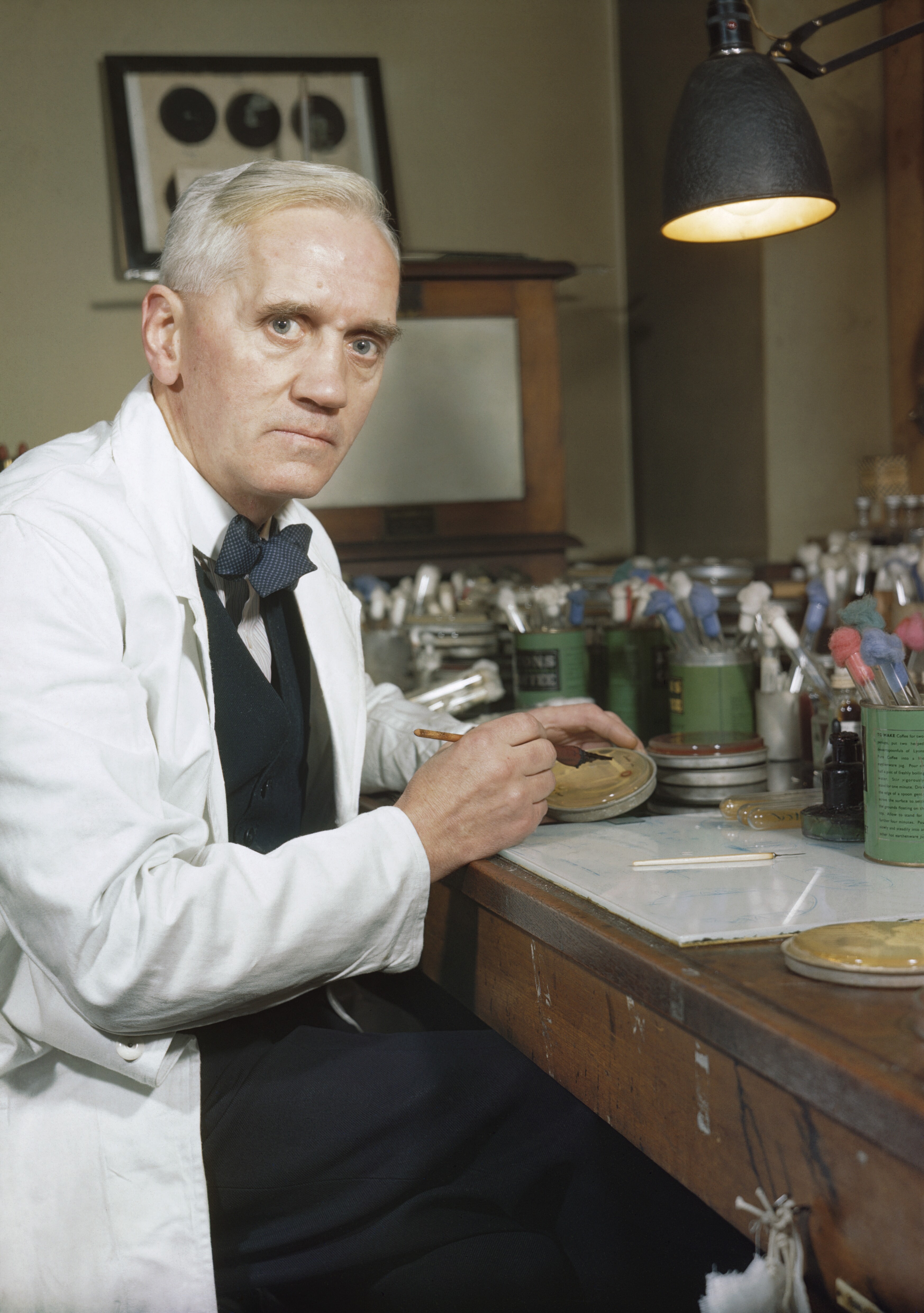 |
| Wikipédia: Alexander Fleming |
By 1927, Fleming was investigating the properties of staphylococci. He was already well-known from his earlier work, and had developed a reputation as a brilliant researcher, but his laboratory was often untidy. On 3 September 1928, Fleming returned to his laboratory having spent August on holiday with his family. Before leaving, he had stacked all his cultures of staphylococci on a bench in a corner of his laboratory. On returning, Fleming noticed that one culture was contaminated with a fungus, and that the colonies of staphylococci that had immediately surrounded it had been destroyed, whereas other colonies farther away were normal. Fleming showed the contaminated culture to his former assistant Merlin Price, who reminded him, "That's how you discovered lysozyme." Fleming grew the mould in a pure culture and found that it produced a substance that killed a number of disease-causing bacteria.
He identified the mould as being from the Penicillium genus, and, after some months of calling it "mould juice", named the substance it released penicillin on 7 March 1929.
He investigated its positive anti-bacterial effect on many organisms, and noticed that it affected bacteria such as staphylococci and many other Gram-positive pathogens that causescarlet fever, pneumonia, meningitis and diphtheria, but not typhoid fever or paratyphoid fever, which are caused by Gram-negative bacteria, for which he was seeking a cure at the time. It also affected Neisseria gonorrhoee, which causes gonorrhoea although this bacterium is Gram-negative.
Fleming published his discovery in 1929, in the British Journal of Experimental Pathology, but little attention was paid to his article. Fleming continued his investigations, but found that cultivating penicillium was quite difficult, and that after having grown the mould, it was even more difficult to isolate the antibiotic agent. Fleming's impression was that because of the problem of producing it in quantity, and because its action appeared to be rather slow, penicillin would not be important in treating infection. Fleming also became convinced that penicillin would not last long enough in the human body (in vivo) to kill bacteria effectively. Many clinical tests were inconclusive, probably because it had been used as a surface antiseptic. In the 1930s, Fleming’s trials occasionally showed more promise, and he continued, until 1940, to try to interest a chemist skilled enough to further refine usable penicillin. Fleming finally abandoned penicillin, and not long after he did, Howard Florey and Ernst Boris Chain at the Radcliffe Infirmary in Oxford took up researching and mass-producing it, with funds from the U.S. and British governments. They started mass production after the bombing of Pearl Harbor. When D-Day arrived, they had made enough penicillin to treat all the wounded Allied forces.
Purification and stabilisation
In Oxford, Ernst Boris Chain and Edward Abraham worked out how to isolate and concentrate penicillin. Abraham was the first to propose the correct structure of penicillin. Shortly after the team published its first results in 1940, Fleming telephoned Howard Florey, Chain's head of department, to say that he would be visiting within the next few days. When Chain heard that he was coming, he remarked "Good God! I thought he was dead."
Norman Heatley suggested transferring the active ingredient of penicillin back into water by changing its acidity. This produced enough of the drug to begin testing on animals. There were many more people involved in the Oxford team, and at one point the entire Dunn School was involved in its production.
After the team had developed a method of purifying penicillin to an effective first stable form in 1940, several clinical trials ensued, and their amazing success inspired the team to develop methods for mass production and mass distribution in 1945.
Fleming was modest about his part in the development of penicillin, describing his fame as the "Fleming Myth" and he praised Florey and Chain for transforming the laboratory curiosity into a practical drug.
Fleming was the first to discover the properties of the active substance, giving him the privilege of naming it: penicillin. He also kept, grew and distributed the original mould for twelve years, and continued until 1940 to try to get help from any chemist who had enough skill to make penicillin. But Sir Henry Harris said in 1998:"Without Fleming, no Chain; without Chain, no Florey; without Florey, no Heatley; without Heatley, no penicillin."
Fleming's accidental discovery and isolation of penicillin in September 1928 marks the start of modern antibiotics. Before that, several scientists had published or pointed out that mould or penicillium sp. were able to inhibit bacterial growth, and even to cure bacterial infections in animal (Ernest Duchesne in 1897 in his thesis "Contribution to the study of vital competition in micro-organisms: antagonism between moulds and microbes", or also Clodomiro Picado Twight whose work at Institut Pasteur in 1923 on the inhibiting action of fungi of the "Penicillin sp" genre in the growth of staphylococci drew little interest from the direction of the Institut at the time). Fleming was the first to push these studies further by isolating the penicillin, and by being motivated enough to promote his discovery at a larger scale. Fleming also discovered very early that bacteria developed antibiotic resistance whenever too little penicillin was used or when it was used for too short a period. Almroth Wright had predicted antibiotic resistance even before it was noticed during experiments.
Fleming cautioned about the use of penicillin in his many speeches around the world. He cautioned not to use penicillin unless there was a properly diagnosed reason for it to be used, and that if it were used, never to use too little, or for too short a period, since these are the circumstances under which bacterial resistance to antibiotics develops.


Nenhum comentário:
Postar um comentário